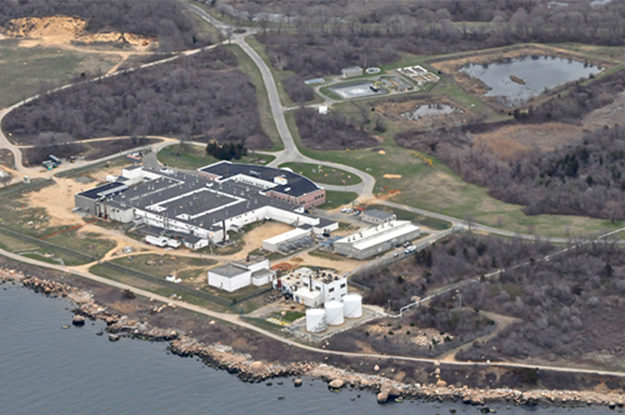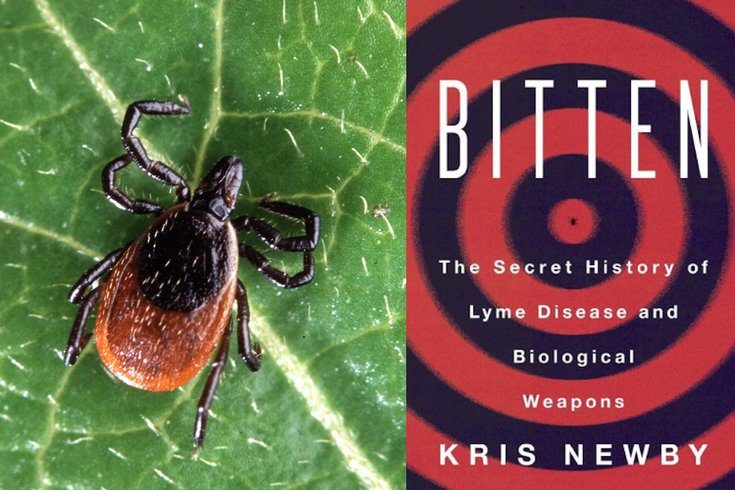The article continued: "If the Inspector General finds that such experiments occurred, then, according to the bill, they must provide the House and Senate Armed Services committees with a report on the scope of the research and 'whether any ticks or insects used in such experiments were released outside of any laboratory by accident or experimental design'...potentially leading to the spread of diseases such as Lyme."
The measure was introduced by Representative Chris Smith, a New Jersey Republican, "who was 'inspired' by several books and articles claiming that the U.S. government had conducted research at facilities such as Fort Detrick, Maryland, and Plum Island, New York, for this purpose."
One of the books, published earlier this year, was Bitten: The Secret History of Lyme Disease and Biological Weapons by Stanford University science writer Kris Newby. It includes interviews with Willy Burgdorfer who is credited with having discovered the pathogen that causes Lyme disease and earlier developed bioweapons for the Department of Defense. Said Smith on the House floor:
"Those interviews combined with access to Dr. Burdorfer's lab files suggest that he and other bioweapons specialists stuffed ticks with pathogens to cause severe disability, disease — even death — to potential enemies. With Lyme disease and other tick-borne diseases exploding in the United States...Americans have a right to know whether any of this is true."Whether Lyme disease resulted from activities on Plum Island, a mile-and-a-half off the North Fork of Long Island, New York and 10 miles from Old Lyme, Connecticut — where the first cases surfaced in 1975 and thus where the disease got its name — is an issue I've pursued since tick-borne Lyme disease became widespread on Long Island where I have long been based as a journalist. I've been writing articles and doing television programs about Plum Island for decades.
A 1982 book linking Plum Island and Lyme disease was The Belarus Secret: The Nazi Connection in America written by John Loftus, an attorney specializing in pursuing Nazis for the Office of Special Investigations of the U.S. Department of Justice. He tells of former "Nazi germ warfare scientists" brought to the U.S. after World War II who "experimented with poison ticks dropped from planes to spread rare diseases. I have received some information suggesting that the U.S. tested some of these poison ticks on the Plum Island artillery range during the early 1950s...Most of the germ warfare records have been shredded, but there is a top secret U.S. document confirming that 'clandestine attacks on crops and animals' took place at this time."
Loftus points to "the hypothesis that the poison ticks are the source of the Lyme disease spirochete." And adds: "Sooner or later the whole truth will come out, but probably not in my lifetime."
Comment:
The above quotes also appear in the preface to the updated version of The Belarus Secret from 2010, America's Nazi Secret. See also the comment after the article.
In 1995, with Lyme disease epidemic on Long Island, indeed in many areas of the U.S., a just-elected congressman from Long Island, Michael Forbes, conducted what he told me would be a "raid" on Plum Island. He would go to the Plum Island Animal Disease Center and demand information about tick weaponization there and a link to Lyme disease as related by Loftus. He took John McDonald, an investigative reporter at the Long Island newspaper Newsday, and me.
McDonald has also focused on Plum Island. In a November 21, 1993 article in Newsday, McDonald documented the biological warfare mission of Plum Island with records he obtained. The piece began: "A 1950s military plan to cripple the Soviet economy by killing horses, cattle and swine called for making biological warfare weapons out of exotic animal diseases at a Plum Island laboratory, now-declassified Army records reveal." A facsimile of one of the records, dated 1951, covered the front page of that issue of Newsday.
Comment: US operations against Russia continue to this day:
Pentagon Biological Weapons Program Never Ended: US Bio-labs Around The World
The article went on: "Documents and interviews disclose for the first time what officials have denied for years: that the mysterious and closely guarded animal lab off the East End of Long Island was originally designed to conduct top-secret research into replicating dangerous viruses that could be used to destroy enemy livestock."
When Representative Forbes on his "raid" on Fire Island confronted the center's director, Dr. Harley Moon, in the presence of McDonald and me, under intensive questioning Moon took the position that "we don't have any paperwork on that."
Then in 2004 came another book, Lab 257, also by an attorney, Michael Carroll, formerly a law firm associate of the late New York State Governor Mario Cuomo. Using documents he found in the National Archives, he exposes a full story about Plum Island. He detailed how Erich Traub during World War II was the "lab chief of Insel Riems — a secret Nazi biological warfare laboratory" in the Baltic with a mission in World War II of poisoning cattle in the Soviet Union.
Traub and hundreds of other Nazi scientists among them Wernher von Braun were brought to the U.S. in the U.S. government's "Project Paperclip" after the war. Traub was the "father" of the establishment of a biowarfare center on Plum Island, says Lab 257, with the same mission Insel Riems had — going after Soviet livestock now with the Cold War having begun.
Lab 257 relates how "animal handlers and a scientist released ticks outdoors on the island. They called him the Nazi scientist...they were inoculating these ticks." Carroll, too, points to the possibility of Lyme disease emerging from activities on Plum Island with ticks.
Before the war, Traub spent time in the U.S. "Ironically, Traub spent the prewar period of his scientific career on a fellowship at the Rockefeller Institute in Princeton, New Jersey, perfecting his skills in viruses and bacteria under the tutelage of American experts before returning to Nazi Germany on the eve of war," writes Carroll. While in the U.S. in the 1930s, too, relates the book, Traub was a member of the Amerika-Deutscher Volksbund which was involved in pro-Nazi rallies held weekly in Yaphank on Long Island for Nazis from the New York Metropolitan Area.
Making use of scientific contacts he had made before the war, when Traub came back to the U.S. under Project Paperclip, Traub's "detailed explanation of the secret operation on Insel Riems" given to officials at Fort Detrick in Maryland, the Army's biological warfare headquarters, and to the CIA, "laid the groundwater for Fort Detrick's offshore germ warfare animal disease lab on Plum Island," says Lab 257.
Lab 257 also tells of why in 1954 suddenly Plum Island was transferred from the Department of Defense to the Department of Agriculture: the Pentagon becoming concerned about having to feed millions of people in the Soviet Union if it destroyed their food animals. The Joint Chiefs of Staff "found that a war with the U.S.S.R. would best be fought with conventional and nuclear means, and biological warfare against humans not against food animals," says Lab 257. "Destroying the food supply meant having to feed millions of starving Russians after winning a war"
Still, Lab 257 questions whether there ever was a clean break. Officials at the Plum Island Animal Disease Center have insisted over the years — including to me — that the center's function after the Army ended its management has been to conduct research into foreign animal diseases not found in the U.S. especially foot-and-mouth disease — but "defensive" biological warfare research remains being done, they also say.
Largely because of security concerns involving Plum Island in the wake of the 9/11 attack — a 2003 a report by the Government Accountability Office cited the ease of terrorists to land on the island which sits amidst busy marine traffic lanes and close by the population center of the U.S. — New York City to the west, Boston to the north — the U.S. government moved to move Plum Island's activities to a new federal laboratory to be built in Kansas. What is to be called the National Bio and Agro-defense Facility, a $1.25 billion project, is "expected to be operational by 2022-2023" on the campus of Kansas State University, according to the university's website.
But the congressman now representing the New York district in which Plum Island is located, Lee Zeldin, close personally and politically to President Trump, has introduced legislation and been pushing hard for the federal government not to sell Plum Island but to hold on to it as a "nature preserve" — and allowing research to continue on it.
About The Author
Karl Grossman, professor of journalism at State University of New York/College at Old Westbury, and is the author of the book, The Wrong Stuff: The Space's Program's Nuclear Threat to Our Planet. Grossman is an associate of the media watch group Fairness and Accuracy in Reporting (FAIR). He is a contributor to Hopeless: Barack Obama and the Politics of Illusion.








Please recall the SOTT article about how the USAF were dropping piles of non-indigenous fleas and ticks into the winter frostland of N. Korea, and how one (or more) of the finders died, from such USAF Air Dropped "PILES of critters each carrying multiple types of diseases of types which were mutually inconsistent such as say a tropical disease like
malaria'longo dongo jungle fever ' and also typhus from colder climes, plus the plague, TB, etc..Anyone have that link?
R.C.
*Made that one up. Gotta have humor.
RC